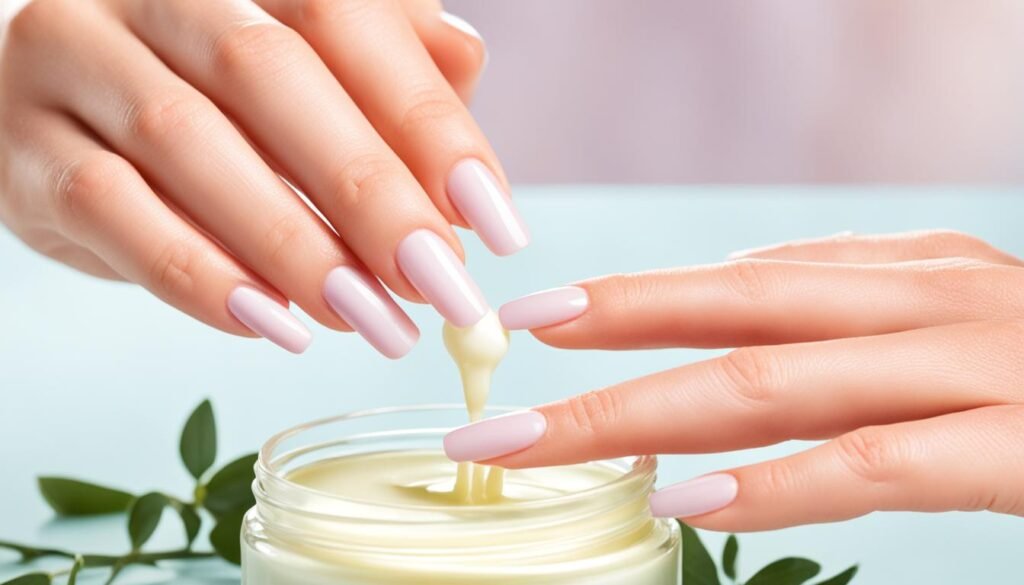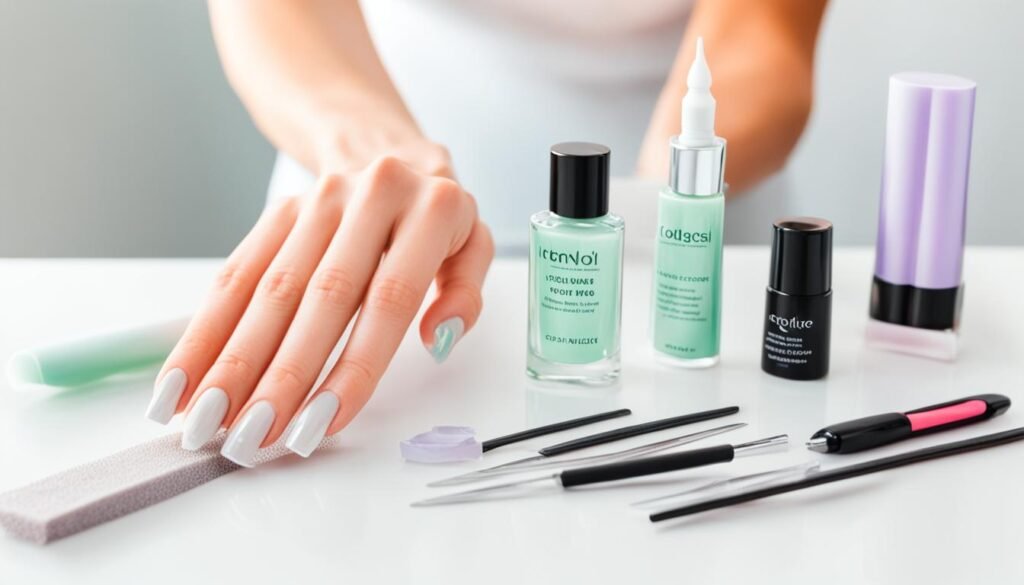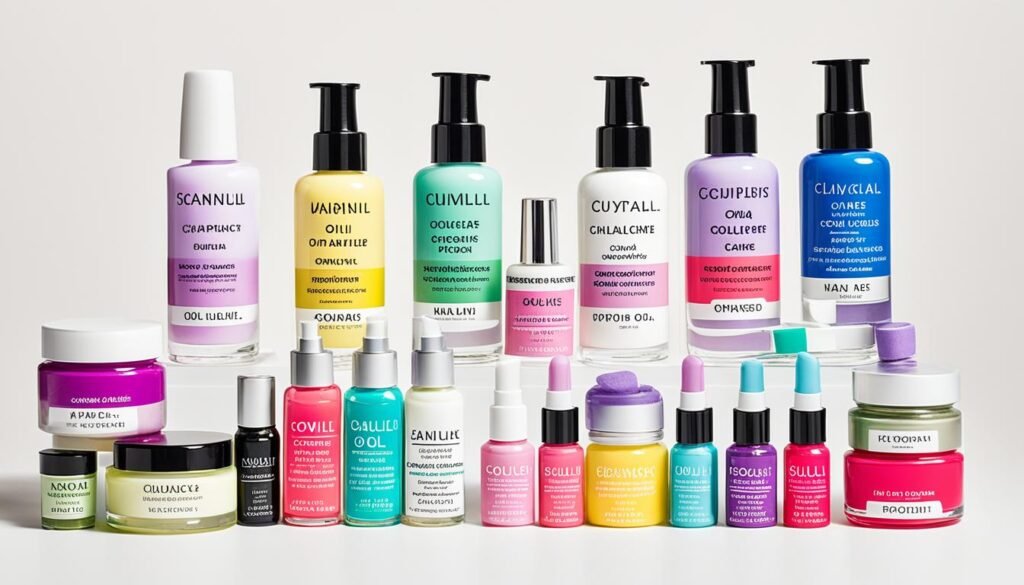Have you ever wondered how to achieve healthy, strong nails that always look their best? Is your current nail care routine falling short, leaving you feeling frustrated with brittle, weak nails? If so, you’re in the right place. In this article, we will unravel the secrets to maintaining beautiful nails and provide you with practical nail care tips, DIY techniques, and the best nail care products to transform your nail health. Get ready to give your nails the TLC they deserve!
Key Takeaways:
- Follow a regular nail care routine to maintain strong and healthy nails.
- Learn different techniques and DIY tips to improve your nail care routine.
- Discover the best nail care products that can enhance your nail health.
- Understand what is considered normal and abnormal for your fingernails and when to seek professional help.
- Avoid common nail care mistakes that can lead to nail damage.
Understanding Your Fingernails: What’s Normal, What’s Not
Your fingernails are composed of a protein called keratin and grow from the base of the nail under the cuticle. Healthy nails should be smooth, uniform in color and consistency, and free of spots or discoloration. However, certain nail conditions can indicate underlying issues that require attention. Paying attention to changes in your nails can help identify potential problems and seek appropriate care.
Common Nail Conditions and What They May Indicate
Ridges: Vertical or horizontal ridges on the nails are often harmless and a natural consequence of aging. However, deeply pronounced ridges may be a sign of nutrient deficiencies or health conditions.
Discoloration: Nails should normally be pinkish or have a consistent color across the entire nail bed. Discoloration, such as yellowing, darkening, or the presence of white spots, can indicate fungal infections, nutritional deficiencies, or underlying medical conditions.
Nail Shape and Thickness: While nail shapes may vary, drastic changes in shape or thickness can be a cause for concern. Spoon-shaped nails (koilonychia) may suggest iron deficiency anemia, while excessively thick or curved nails may indicate thyroid or lung issues.
Nail Separation: When the nail plate starts separating from the nail bed, it can be a sign of a condition known as onycholysis. Causes can range from trauma, infection, psoriasis, to certain medications. It’s important to seek professional advice for proper diagnosis and care.
Bleeding Nails: Injuries or trauma to the nail bed can lead to bleeding nails. If bleeding occurs without any apparent cause, it may indicate an underlying blood clotting disorder or vascular issue and should be evaluated by a healthcare provider.
Nail Swelling and Pain: Swelling and pain around the nail area can be a sign of an infection, such as paronychia or a hangnail. If the swelling and pain persist, it’s important to seek medical attention to prevent further complications.
Nail Growth: Normal nail growth varies, but an increase in the rate of nail growth may indicate underlying conditions such as thyroid disorders or nutritional imbalances. Slower nail growth can be a natural part of the aging process but may also be related to poor circulation or nutritional deficiencies.
When to Seek Professional Advice
“It’s essential to pay attention to your nail health and seek medical advice when you notice any abnormal changes or persistent nail conditions. Consulting a doctor or dermatologist can help diagnose the underlying causes and recommend appropriate treatment options. Early detection and intervention can prevent further complications and promote nail health.”
Fingernail Care Do’s
Proper care is essential for maintaining healthy and strong nails. By following the right practices, you can ensure the well-being of your nails. Here are some key do’s for fingernail care:
1. Keep Your Nails Dry and Clean
It is important to keep your nails dry to prevent the growth of bacteria. After washing your hands or exposing your nails to water, make sure to thoroughly dry them. Additionally, regularly clean your nails with a mild soap and a soft brush to remove dirt and debris.
2. Trim Your Nails Properly
Use sharp manicure scissors or clippers to trim your nails. It is recommended to cut them straight across and round the tips gently. Avoid cutting too close to the skin, as this can cause discomfort and increase the risk of ingrown nails.
3. Moisturize Your Nails and Cuticles
Regularly moisturizing your nails and cuticles is crucial for their health and hydration. Rub hand lotion or cuticle oil into your nails and cuticles to keep them moisturized. This helps prevent dryness, brittleness, and cracking.
4. Strengthen Weak Nails with Nail Hardeners
If you have weak nails that are prone to breaking or peeling, consider using a nail hardener. Nail hardeners are formulated to strengthen and protect the nails, making them less susceptible to damage. Apply the nail hardener according to the instructions provided.
Tip: Look for a nail hardener that contains ingredients like biotin, which is known to promote nail health and strength.
5. Consider Biotin Supplements
Some research suggests that taking biotin supplements may contribute to the overall health and growth of nails. Biotin is a B-vitamin that supports the production of keratin, the protein that makes up nails. Consult with a healthcare professional before incorporating biotin supplements into your routine.

Incorporating these fingernail care do’s into your routine will help you maintain healthy and beautiful nails. Remember to prioritize dryness and cleanliness, trim your nails properly, moisturize regularly, use nail hardeners when necessary, and consider biotin supplements for added support.
| Fingernail Care Do’s |
|---|
| Keep your nails dry and clean |
| Trim your nails properly |
| Moisturize your nails and cuticles |
| Strengthen weak nails with nail hardeners |
| Consider biotin supplements |
Fingernail Care Don’ts
While proper nail care is crucial for maintaining healthy nails, it’s equally important to avoid certain habits and products that can cause damage. By steering clear of harmful practices and being mindful of the products you use, you can keep your nails in optimal condition. Here are some don’ts to keep in mind:
Avoid Nail Biting
Biting your nails can not only result in unsightly nails but also lead to infections. The habit of nail biting exposes your nails and surrounding skin to bacteria, increasing the risk of painful nail bed infections. Break the nail-biting habit by using bitter-tasting nail polishes specifically designed to discourage nail biting. Alternatively, you can keep your nails neatly trimmed and file them regularly to reduce the urge to bite them.
Refrain from Cuticle Picking
Picking at your cuticles can cause damage and lead to infections. The cuticles act as a protective barrier against bacteria and fungi, keeping your nails healthy. When you pick at your cuticles, you risk tearing the delicate skin, leaving it vulnerable to infection. Instead of picking, gently push back your cuticles using a cuticle pusher or orangewood stick after a warm soak. This promotes healthy nail growth without compromising the protective function of the cuticles.
Avoid Harsh Nail Care Products
Using harsh nail care products, such as nail polish removers that contain acetone, can strip your nails of their natural oils and moisture. This can lead to dry, brittle nails that are prone to breakage. Opt for acetone-free nail polish removers or gentle, non-drying formulas. Additionally, try to minimize the use of nail polish removers, as they can be drying to both the nails and the surrounding skin.
Don’t Ignore Nail Problems
Ignoring nail problems can result in the worsening of underlying issues. If you notice any persistent nail problems, such as discoloration, changes in nail shape, or pain, it’s important to seek professional advice. Consult a dermatologist or doctor who can provide the necessary evaluation and treatment to address any nail issues you may be experiencing.
By avoiding nail biting, cuticle picking, harsh nail care products, and ignoring nail problems, you can help promote the health and strength of your nails.
| Nail Care Don’ts | Impact on Nails |
|---|---|
| Nail Biting | Increases the risk of infections and results in unsightly nails |
| Cuticle Picking | Can cause damage, tearing, and infections |
| Harsh Nail Care Products | Can strip nails of moisture, leading to dry and brittle nails |
| Ignoring Nail Problems | May exacerbate underlying issues and delay necessary treatment |
Manicure and Pedicure Considerations
When it comes to getting manicures or pedicures, there are several factors to consider to ensure a safe and enjoyable experience. From choosing the right salon to understanding the importance of proper sanitization, here are some key considerations to keep in mind.
-
Salon Selection
Make sure to choose a reputable salon that holds a valid state license. Look for salons that prioritize cleanliness, safety, and customer satisfaction. By selecting a well-established salon, you can have peace of mind knowing that they adhere to industry standards and regulations.
-
Technician Licensing
Verify that the technicians performing the manicure or pedicure are licensed by the state board. Licensed technicians have undergone the necessary training and education to provide professional and skilled services. This ensures that your nails are in capable hands and reduces the risk of any mishaps.
-
Cuticle Care
It’s important to understand that cuticles serve as a protective barrier for your nails. Avoid having them forcefully removed during your manicure or pedicure. Instead, ask the technician to gently push back the cuticles to maintain their integrity and protect against infections.
-
Tool Sterilization
Prior to the procedure, inquire about the salon’s tool sterilization practices. All tools, including nail clippers, files, and cuticle pushers, should be properly sanitized to eliminate the risk of bacteria and infections. Confirm that the salon follows strict sterilization protocols to ensure your safety.
-
Foot Bath Cleanliness
Foot baths are commonly used during pedicures to provide a relaxing and cleansing experience. However, it’s crucial that these foot baths are cleaned and disinfected between clients. Inquire about the salon’s foot bath cleanliness practices, ensuring that they use a bleach solution or other effective disinfectants to maintain a hygienic environment.
By considering these factors when choosing a salon and during your manicure or pedicure, you can prioritize both the aesthetic results and the health of your nails. Remember, a little extra attention to detail goes a long way in ensuring a positive and safe experience.
Tips for Healthy and Strong Nails
To maintain healthy and strong nails, it’s important to follow a few key tips. By incorporating these practices into your nail care routine, you can keep your nails looking their best.
1. Maintain an Appropriate Nail Length
Regularly trim your nails to an appropriate length to prevent snags and breakage. Avoid letting your nails grow too long, as this can make them more susceptible to damage. Use a nail clipper or file to achieve the desired length.
2. Use a Nail File in One Direction
When shaping your nails, always file them in one direction. Avoid sawing back and forth, as this can weaken the nails and lead to splitting. Choose a high-quality nail file and gently shape the edges of your nails to your preferred style.
3. Properly Maintain Your Nail Tools
Take care of your nail tools by disinfecting them regularly. Clean your nail clippers, files, and other tools with soap and water, or use rubbing alcohol to sanitize them. This helps prevent the spread of bacteria and keeps your tools in good condition.
4. Pay Attention to Cuticle Care
It’s important to care for your cuticles to maintain optimal nail health. Avoid cutting or removing your cuticles, as they serve as a protective barrier for your nails. Instead, gently push back the cuticles using a cuticle pusher or an orange stick after showering or bathing, when they are softer.
5. Apply a Base Coat and Top Coat
Before painting your nails, always apply a base coat. This forms a protective layer between your nails and the colored polish, preventing staining and promoting overall nail health. After painting your nails, apply a top coat to seal in the color and add a layer of protection. This can help prolong the lifespan of your manicure and prevent chipping.
6. Use Nail Care Products
Incorporate nail care products into your routine to promote healthy and strong nails. Look for products that contain ingredients like biotin or keratin, which can help strengthen your nails. Consider using a nail moisturizer or cuticle oil to keep your nails and cuticles hydrated and nourished.
By following these tips, you can maintain healthy and strong nails that look beautiful and well-groomed.

Comparison of Different Nail Care Techniques
| Nail Care Technique | Benefits |
|---|---|
| Regular nail trimming | Prevents snags and breakage |
| Using a nail file in one direction | Avoids weakening of the nails |
| Proper maintenance of nail tools | Prevents the spread of bacteria |
| Gentle cuticle care | Maintains nail protection |
| Application of base coat and top coat | Prevents staining and chipping |
| Use of nail care products | Strengthens and nourishes the nails |
Minimizing Nail Damage from Acrylic and Gel Treatments
Acrylic and gel manicures have become popular choices for those looking to enhance the appearance of their nails. However, it’s important to be aware of the potential damage these treatments can cause to your nails and skin. One key concern with gel manicures is the exposure to UV light during the curing process, which can be harmful and increase the risk of skin cancer.
To protect yourself from UV exposure, it’s recommended to apply sunscreen with a high SPF to your hands and fingers before undergoing a gel manicure or acrylic treatment. This will help shield your skin from the harmful effects of the UV light.
Another measure you can take to minimize the damage is to consider using special gloves that only expose the nails during the UV curing process. This way, you can protect the surrounding skin while still achieving the desired manicure.
Alternatively, you may want to explore safer alternatives such as CND’s Shellac Luxe salon service. This innovative option provides long-lasting and beautiful results without the potential harm associated with traditional gel manicures.
Giving Your Nails a Break and Allowing for Natural Rejuvenation
It’s important to give your nails a break from nail products and treatments to allow for natural rejuvenation. Constantly applying nail polish or indulging in elaborate nail art can lead to drying, discoloration, and weakening of the nails. Instead, embrace a simpler approach by opting for a clear gloss or going “all natural” for a period of time.
“Allow your nails to breathe and recover by letting go of excessive adornments. Embracing the natural beauty of your nails not only gives them a chance to regenerate but also promotes their overall health and strength.”
During this break, you can also avoid using nail polish removers, as they can further weaken your nails. By eliminating the use of harsh removers, you give your nails the opportunity to regain their natural strength and resilience.
Take a step back and appreciate the simplicity of well-groomed nails without any embellishments. This break allows for natural rejuvenation, helping your nails regain their vitality and shine.
To further inspire you, here’s an image showcasing the beauty of natural nails:
| Benefits of Giving Your Nails a Break | Tips for Natural Nail Rejuvenation |
|---|---|
|
|
Moisturizing Your Hands and Nails
Moisturizing your hands and nails is crucial for maintaining their health and vitality. With regular care, you can prevent dryness, brittleness, and flakiness, ensuring your hands and nails look and feel their best. Here are some essential tips to keep your hands and nails well-moisturized:
1. Hand Moisturizer: Use a high-quality hand moisturizer regularly to keep your hands hydrated throughout the day. Look for a moisturizer that is specifically formulated for dry skin and contains nourishing ingredients, such as shea butter or hyaluronic acid. Apply the moisturizer after washing your hands or whenever they feel dry.
2. Nail Moisturizer: Just like your hands, your nails also need moisture to stay healthy. Invest in a nail moisturizer or cuticle cream to provide hydrating care to your nails and cuticles. Massage the moisturizer into your nails and cuticles before bedtime to allow it to penetrate deeply overnight.
3. Nutrient-Rich Oils: Consider incorporating nutrient-rich oils, such as almond oil or avocado oil, into your nail care routine. These oils are packed with vitamins and fatty acids that nourish and hydrate the nails, preventing them from becoming dry or brittle. Apply a few drops of oil to your nails and cuticles, gently massaging it in for optimal absorption.
4. Cuticle Care: Proper cuticle care is vital for nail hydration. The cuticles act as a protective barrier for the nails, and maintaining their health is crucial for preventing moisture loss. Push back your cuticles gently using a cuticle pusher, keeping them well-moisturized with the help of cuticle oils or serums.
Moisturizing your hands and nails not only improves their appearance but also strengthens and nourishes them from within. By following these simple tips and incorporating them into your daily routine, you can enjoy healthy, hydrated hands and beautiful nails that look their best.
Expert Tip:
“Consistency is key when it comes to moisturizing your hands and nails. Make it a habit to apply hand and nail moisturizers regularly, and don’t forget to pay attention to your cuticles. Your hands and nails will thank you for the extra care!” – Dr. Emma Roberts, Dermatologist at Mineral Tones
Healthy Habits for Nail Care
Along with proper nail care techniques, incorporating healthy habits into your routine can significantly contribute to the overall health and strength of your nails. By following these tips, you can maintain beautiful and strong nails for years to come.
First and foremost, practice good hand hygiene by washing your hands regularly with soap and water. However, it’s important to keep your nails dry afterwards to prevent them from becoming soft and prone to breakage.
Furthermore, it’s crucial to protect your nails from excessive moisture, harsh chemicals, and trauma. Whenever you engage in activities that could potentially damage your nails, such as cleaning or gardening, wear protective gloves. This simple step can go a long way in preserving the health and strength of your nails.
In addition to external protection, maintaining a healthy lifestyle is essential for strong and beautiful nails. A balanced diet rich in protein, fruits, vegetables, and whole grains provides the necessary nutrients to support nail health. Including foods rich in omega-3 fatty acids, such as salmon and walnuts, can also contribute to the overall strength and appearance of your nails.
Lastly, don’t forget to stay adequately hydrated. Drinking enough water throughout the day helps keep your nails and cuticles moisturized from within, preventing dryness and brittleness. Make it a habit to carry a water bottle with you and sip on water regularly to stay hydrated and support your overall nail health.

